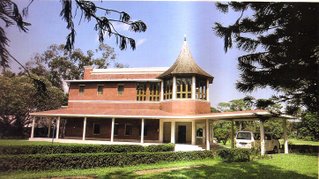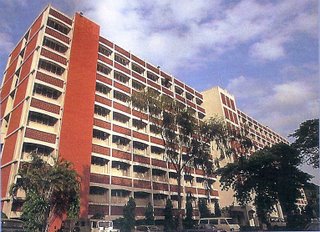
Nimtali Palace
When the capital of the Subah-i-Bangla was shifted from Dhaka to Murshidabad in about 1717, Dhaka was made the seat of a naib-nazim (Deputy-Governor of a sub-province) comprising the greater part of present Bangladesh.
Nimtali Palace was built towards the end of the Mughal rule in Dhaka as a residence of the naib-nazim (Deputy-Governor) of Dhaka Province in 1765-66. It was situated in the Nimtali ward and popularly called the Nimtali Kuthi (Nimtali Palace). All have disappeared over time, but only one gateway (Nimtali Deuri) of the palace still remains.
The naib-nazim, Nawab Jasarat Khan resided in one of the many abandoned Mughal palaces or Forts. In 1763, as a reprisal after Nawab Siraj-ud-Dowla’s attack on Calcutta, the British Army officer Lt. Swinton stormed into Dhaka and occupied the 'fort' as his residence. The naib-nazim who lived in the main fort in Dhaka (the present central jail) was not in Dhaka, and he was taken as a prisoner by Mir Qasim for his secret liasion with the British.
In 1765, Lord Clive re-appointed Jasarat Khan as the naib-nazim of Dhaka. He found his residence occupied so he stayed in the Boro Katra, another old palace of the Mughals. Swinton built a new residence at Nimtali hastily and completed by 1766 -- the first noted building built during the Colonial Period in Dhaka.
Nimtali Palace occupied a considerable area on the northern side of the city between the modern Nimtali Mahalla and the High Court building and consisted of a number of separate buildings. Judging from the only extant gateway, it may be assumed, the Nimtali Deuri was built after the usual Mughal palace designs with several gateways, inner court, private residences, place of prayer, tanks or water reservoirs, barracks for soldiers and quarters of staff, gardens and the like. The kiosk shaped cupolas on the roof, the balconies, and mouldings in parapet, plinth and polygonal shape are largely Mughal.
Nimtali Deuri was part of the socio-religious life of the Dhakaites. Early nineteenth century paintings, now at the National Museum, depict that the Eid processions used to originate and terminate at the Nimtali Deuri. Another significant event was the flag music, played from the Deuri gallery.
Thus the Palace of the naib-nazims of Dhaka and the surrounding lands, after passing through various vicissitudes and owners, eventually became the property of the Dhaka University. The sole surviving gateway, now lies within the compound of the Asiatic Society.
Nimtali Palace was built towards the end of the Mughal rule in Dhaka as a residence of the naib-nazim (Deputy-Governor) of Dhaka Province in 1765-66. It was situated in the Nimtali ward and popularly called the Nimtali Kuthi (Nimtali Palace). All have disappeared over time, but only one gateway (Nimtali Deuri) of the palace still remains.
The naib-nazim, Nawab Jasarat Khan resided in one of the many abandoned Mughal palaces or Forts. In 1763, as a reprisal after Nawab Siraj-ud-Dowla’s attack on Calcutta, the British Army officer Lt. Swinton stormed into Dhaka and occupied the 'fort' as his residence. The naib-nazim who lived in the main fort in Dhaka (the present central jail) was not in Dhaka, and he was taken as a prisoner by Mir Qasim for his secret liasion with the British.
In 1765, Lord Clive re-appointed Jasarat Khan as the naib-nazim of Dhaka. He found his residence occupied so he stayed in the Boro Katra, another old palace of the Mughals. Swinton built a new residence at Nimtali hastily and completed by 1766 -- the first noted building built during the Colonial Period in Dhaka.
Nimtali Palace occupied a considerable area on the northern side of the city between the modern Nimtali Mahalla and the High Court building and consisted of a number of separate buildings. Judging from the only extant gateway, it may be assumed, the Nimtali Deuri was built after the usual Mughal palace designs with several gateways, inner court, private residences, place of prayer, tanks or water reservoirs, barracks for soldiers and quarters of staff, gardens and the like. The kiosk shaped cupolas on the roof, the balconies, and mouldings in parapet, plinth and polygonal shape are largely Mughal.
Nimtali Deuri was part of the socio-religious life of the Dhakaites. Early nineteenth century paintings, now at the National Museum, depict that the Eid processions used to originate and terminate at the Nimtali Deuri. Another significant event was the flag music, played from the Deuri gallery.
Thus the Palace of the naib-nazims of Dhaka and the surrounding lands, after passing through various vicissitudes and owners, eventually became the property of the Dhaka University. The sole surviving gateway, now lies within the compound of the Asiatic Society.

Sugandha- State Guest House
Originally built in Ramna in the wake of the Partition of Bengal of 1905, the Sugandha was remodeled and renovated to its present form by PWD for the stay of Queen Elizabeth II of England during her State Visit to Bangladesh in Nov 1983.

'Chamery House', another colonial building opposite to Foreign Office, now Headquarter of CIRDAP

Head Office of Public Works Dept (PWD) in Segunbagicha, Dhaka

1 comment:
Lovely pictures, so much information,thank you so much.
Is Chamery house also known as Circuit House?
Im looking for the place I was born in 1957, some Circuit house in the then, Dacca.
shireen.hussain@gmail.com
Post a Comment